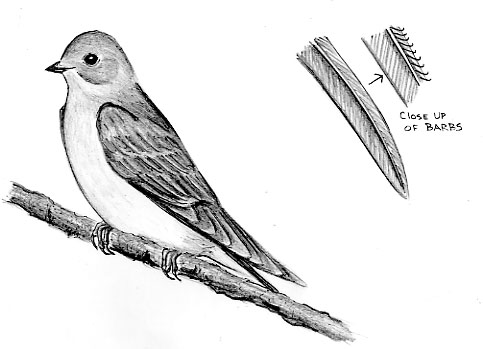
Dear Bird Folks,
I have a question about swallows. I understand that Tree Swallows nest in holes in trees and Barn Swallows live in barns. Their name matches their nesting location. But could you explain about rough-winged swallows? Does the name match the bird’s wings? The pictures of their wings in my book don’t look very rough to me.
– Melissa, Weymouth, MA
Good observation, Melissa,
I never thought about that before, but you are right. Most common names of our swallows come from their nesting habits. In addition to the two you’ve mentioned, Barn and Tree Swallows, there are a few others. Cave Swallows, as their name suggests, nest in caves, honest-to-goodness caves. These birds often share their breeding sites with bats, and occasionally, trolls and hermits. Then there is the Cliff Swallow. True to its name, this bird’s mud nest is regularly located under a rock ledge or cliff. Next are the Bank Swallows. To build their nests they must dig holes into the side of a bank, a sand bank to be exact. The birds are careful not to build nests in monetary banks. Even birds don’t want to be associated with those kinds of banks.
Obviously, the rough-winged swallow’s name has nothing to do with its nesting habitat. Its name more accurately describes the texture of its wings, which truly do have a rough section. However, you can’t see the roughness during field observations or even by looking at photos. The “rough wing” of this bird has to do with tiny barbs on the outer edges of its flight feathers. Rough-winged swallows and the “saw-wings” in Africa are the only swallows with this odd feature. Researchers have yet to discover the reason or a purpose for these barbs. However, it is rumored that early Russian explorers often used the bird’s wings to comb their eyebrows.
Right now I’m betting most people reading this are thinking that they have never seen a rough-winged swallow. I’d also bet that many of those people are wrong. Rough-wings are fairly common birds and are found throughout every one of our lower forty-eight states. Also, they aren’t the kind of birds that like to stay hidden in thickets or are concealed in some muggy swamp. This bird is out there for us all to see. Any location that has other swallows swooping around could have rough-wings, too. The trouble is that these birds are dull and not eye-catching at all. They are like speed limit signs. They’re everywhere but no one pays attention to them. Unlike the colorful Barn Swallow, with its streaming swallowtail, or the Tree Swallow, with its metallic-green back and bright white belly, the rough-wing is a boring, beigey, brown. In fact, this common bird went totally unnoticed until 1838 when Mr. Big Shot, John James Audubon, caught one. But even he didn’t even know it at the time. He thought he had a Bank Swallow. Then he felt the odd barbs on the bird’s wings. Old John James was shocked and thrilled because he had discovered a new species. He made a quick sketch, wrote down the important information and then combed his eyebrows with the bird’s wings.
It’s a good thing that Audubon didn’t try to name this swallow after its nesting location because rough-wings use quite an assortment of nest sites. Their locations of choice are natural tunnels or burrows. Because they apparently lack the excavating skills to dig these burrows, or are simply too lazy to do their own digging, rough-wings typically use burrows that have been dug out by others. Old kingfisher, Bank Swallow and even ground squirrel holes are often used. When those sites aren’t available, rough-wings will accept man-made locations. They have been known to use gutters, drainpipes, holes in bridges and walls. They have even nested in the barrels of cannons. (Cannons? And I thought I lived in a noisy neighborhood.) One spring a pair of rough-winged swallows built a nest inside the framework of a semi-trailer that was parked in the lot next to ours. Unfortunately, as soon as the nest was completed, a truck driver came along, hooked up the trailer and drove it away. The birds were upset but didn’t follow it. They may be willing to nest in gutters and drainpipes, but they understandably draw the line at living in a mobile home.
Because the “rough wings” of the rough-winged swallow aren’t helpful in identification, Melissa, many people find it is easier to ID this bird by its vocalizations. But don’t expect to hear any sweet, melodious singing coming out of this dull-colored bird. Its voice matches its plumage. As the male rough-wing swoops about his territory he gives off a lovely, harsh “brrrt.” This noise may be helpful in identification, but to me it sounds like a bird that is in desperate need of an Alka-Seltzer.
On another subject:
Many folks are reporting “psycho” robins, cardinals and other birds “attacking” their windows. These birds aren’t crazy. They are nesting nearby and are trying to drive the “other” bird (which is their own reflection) out of their territory. I know it’s annoying but the birds will eventually stop and they won’t kill themselves. I feel bad for these birds, though. It’s hard to fight a mirror and win. I fight with my mine every morning and have been slowly losing the battle.